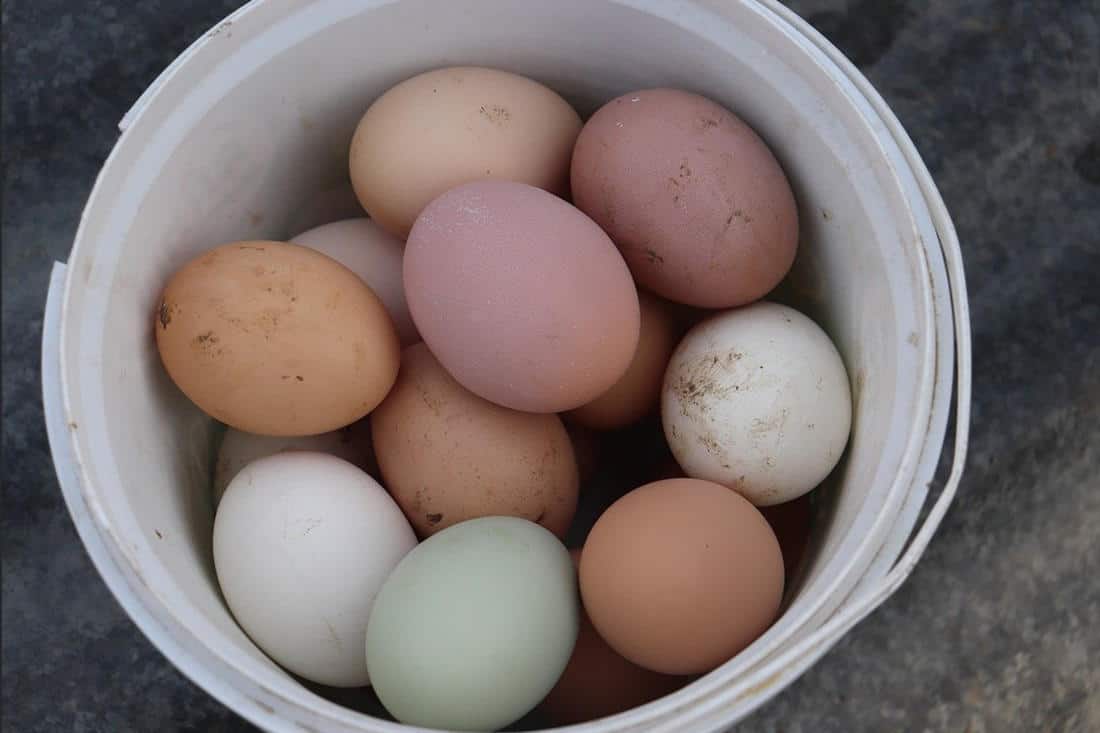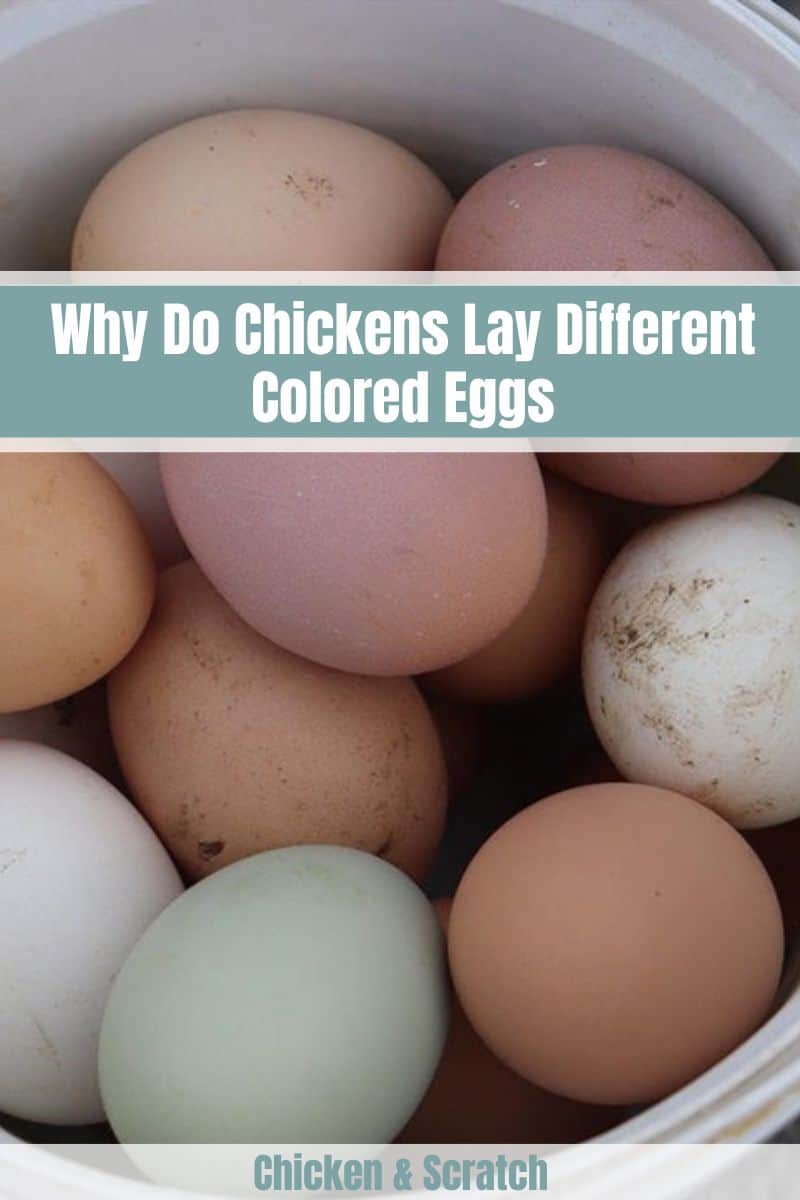As you may have observed in the market or read in an article, chicken eggs come in various colors. And so, you might ask, “Why do chickens lay different colored eggs?” Well, the poultry world is broad and colorful, so you would find it quite fun learning about the intricacies of chickens and their eggs.
Formation of Colored Eggs
Like how nature has blessed chickens with colorful feathers, their eggs also have exciting variations.
While many might think that eggs get their color from having humans harvest and deliberately coloring them with paint or dye, this is certainly not the case. Colored eggs have natural hues and a natural process of achieving these colors.

The color of an egg does not determine its origin. Instead, the egg color is determined by the process it undergoes. A particular egg’s color changes as it passes through the hen’s oviduct. All chicken eggs begin as white eggs as they are calcium in the first place. This is before they pass through the oviduct, where they are in contact with a pigment.
Process of Egg Formation
Pigments start to make contact with the eggshell as it is deposited onto it as the shell develops in the oviduct. This contact results in the variety of hues seen in eggshells. One of the main contributors to colored eggs is the oviduct. This organ is a tube-like place that is found running along the backbone of the chicken. This tubular structure is located between the chicken’s tail and ovary.
The ovaries are where the overall formation of eggs starts. Chicken yolk, also known as an ovum, develops in the ovaries. Once it has completed its development, it begins its journey as it exits the ovary and travels into the oviduct.
In the oviduct, the yolk undergoes a five-step process that ensures it develops into a complete egg without any issues. The egg formation process takes a little longer than twenty-four hours to complete.
The addition of pigment to the eggshell occurs during the fourth stage. This is where pigments make contact and are deposited into the eggshell. The whole process involves the shell gland, a key component in egg formation.
To summarize, various chicken breeds each deposit a unique pigment on the developing shell. These deposits are responsible for the distinct change in the color of the shell’s exterior and, in some instances, its interior.
Chicken Breeds and Their Eggs
The color of a hen’s egg is determined by several factors, such as breed-specific genes in chickens. A chicken’s genetic makeup also affects the color of its eggs. However, the contents and nutrients in an egg are not altered in any way, whatever the eggshell’s color.
Eggshell Color | Breeds |
● Ancona ● Andalusian ● Blue Andalusian ● California White ● Campine ● Egyptian Fayoumis ● Hamburg ● Polish ● White Leghorn | |
● Australorp ● Barred Rock ● Orpington ● Plymouth ● Rhode Island Red ● Sussex | |
● Barnevelder ● Welsummer | |
● Barnevelder ● Empordanesa ● Maran ● Penedesenca | |
● Ameraucana ● Araucana ● Arkansas Blue ● Cream Legbar ● Dongxiang ● Easter Egger ● Lushi ● Whiting True Blue | |
● Ameraucana ● Easter egger ● Favaucana ● Isbar ● Ice Cream Bars ● Olive egger |
The Leghorn chicken is one of the most prevalent layer chickens in the United States. The eggs laid by this breed are white, in contrast to the brown eggs laid by Orpingtons and Plymouth Rocks. On the other hand, the Ameraucana species produces eggs with different shades of blue.
Poultry keepers are discovering more colors as they continue breeding chickens of different breeds. Some keepers can produce eggs with more unusual hues, such as darker shades of green, pink, or even speckled eggs. Eggshell color is determined by the combination of genes from the chicken parents.
The color of these eggs is evident not only on the outside but also on the inside. These hens make it possible by having a type of pigment capable of permeating the entire eggshell.
Some mixes and matches are more popular than others, and this lineup includes Easter Eggers crossed with Olive Egger chickens. As Easter Eggers can produce some unique colors like blue or green, mixing it with a breed that lays brown eggs can give you different shades of green eggs.
A hen cannot change her pigment and, consequently, her eggshell color. However, there may be a change in the eggshells’ hue or shade as she grows older. The color of her eggs may become darker the older the hen gets as she reaches the end of her egg-laying cycle.
The Whats and Whys of Chicken Egg Pigments
As the color of a chicken or eggshell is caused by pigment, learning about these elements is also helpful. The color of an egg is primarily driven by two different kinds of lacquer, which are distinguished visually.
Porphyrin
This is one of the most common pigments in chickens. Porphyrin, a dominant pigment, imparts a brown color to the eggs. Before an egg is released from the oviduct, the bird distributes this pigment on its surface.
There is also some presence of biliverdin and the zinc chelates of biliverdin in the color formation of the eggshell. The pigment is produced in the duct that lines the shell. Porphyrin is coated onto all layers of the surface. This includes the membranes; however, most of it is concentrated and focused on the outer skin of the shell.
Oocyanin
There is significantly less chance of coming across blue eggs; thus, it may be rare for you to find these eggs at the grocery shops near you. The pigment known as oocyanin is responsible for blue eggs.
Oocyanin is a byproduct of the synthesis of bile and is responsible for the bluish tinge that does not occur in brown eggs. Because this pigment is administered at such an early stage in the eggshell development process, the color can penetrate the whole shell entirely. Hence, blue eggs will also have a blue interior.
The amount of each hue varies depending on the chicken’s breed. This is why some chickens lay eggs with a deeper brown or bluer color than others. Certain kinds of chickens can produce green eggs because their genetic makeup allows them to create two different colors: brown and blue.
Speckled Eggs
Sometimes, you may notice some color inconsistencies with some eggs. They are called speckled eggs. Extra calcium deposits are what give speckled eggs their distinctive appearance. Speckled eggs result from disturbances in the egg’s calcification process. It has to do with how the eggs have journeyed through the hen.
The splotches are usually present and created during the earlier stage in the process. The process is supplemented by the egg rotating as it moves through the oviduct. The spotted appearance is achieved as it’s paired with a slow spin rate as it travels through.
Raising Chickens With Colored Eggs

Here’s some exciting information about chickens and the color of their eggs! You can tell the color of their shell by looking at their earlobe. Hens with white earlobes often lay white or very pale-colored eggs. The vast majority of the time, red earlobes indicate brown eggs. While there are always exceptions, it’s a fun thing to learn.
There are various chicken breeds that lay eggs in different colors. Here are some of the best egg-laying chickens to take care of.
Australorps
This record-setting breed lays an astounding 365 eggs in one year, meaning she barely or never skips a day of egg production. This breed is great for a backyard flock since they lay eggs that range in color from pale to medium brown.
Barred Plymouth Rocks
These gorgeous striped hens have a plentiful supply of brown eggs. They are averaged-sized chickens with a high tolerance for the cold. They are very friendly and get along quickly with the other chicken breeds.
Brahmas
This kind of chicken breed is quite huge and produces many brown eggs. If you want to raise these specific kinds of hens, you will require a larger space to provide them with enough living quarters.
Buff Orpingtons
These hens are big, sturdy birds that can withstand the cold and lay light brown eggs. Even during the colder months, they continue to have a strong capacity for egg production. Despite being big, they are exceptionally gentle and would make an excellent addition to the flock in your backyard.
Dominique
These chickens are pretty similar to Barred Rocks in both looks and produce. The distinct difference would be the little comb in the shape of a pea that helps them perform better in extremely cold situations.
Jersey Giants
These chickens are massive large black hens, as one may guess from the breed’s name. They produce eggs that are a medium brown color and are a fantastic option for your flock. However, you must ensure that your coop is big enough to accommodate a flock of huge chickens.
Summary
So, why do chickens lay different colored eggs? The answer is quite complex as the poultry world offers so much diversity. Egg production may be the same, but the distinct characteristics of each breed, like their pigment, play a part in the product. There is more to colored eggs, and it is not the work of paint!


Joseph Hudson has been raising chickens for over 15 years. In 2018, he completed the Agriculture & Natural Resources program at Mt. San Antonio College. He currently raises over 1400 chickens on his 7.5-hectare farm. He keeps sharing his experience on raising healthy and happy chickens on Chicken Scratch The Foundry.













